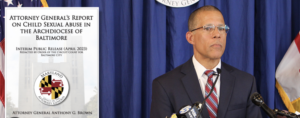
Among the many startling revelations in the new Maryland attorney general’s investigative report on clergy sex crimes and cover-ups in the Archdiocese of Baltimore, this line jumped out at us: “In an internal email in 2002, described the files for (Fr. Bruce) Ball, (Fr. John) Banko, (Fr. Mark) Haight, (Fr. Michael) LaMountain, and (Fr. Raymond) Melville, the priests from other dioceses who committed abuse in Baltimore, breeds seminarians, as the ‘bad boy’ files.”
Bad boys? Normal people would call those who prey on youngsters far more explicit names. This troubling sentence caused us to wonder just how much abuse happened in Maryland Catholic seminaries and how much abuse was perpetrated by seminarians. We were stunned to learn how widespread these horrors were. We at Horowitz Law have read each of the reports issued by attorneys general across the US and believe that this one details more crimes and cover-ups in seminaries than virtually any other. According to the Maryland AG, “Two seminaries, St. Mary’s Seminary in Baltimore City and Mount St. Mary’s Seminary in Emmitsburg, remain active.” At least three abusers were on the faculty of Maryland seminaries: Fr. Vincent Wilbur “Bill” Bechtel, Fr. Joseph Gallagher, and Fr. Francis Sweeney. Seminarians molested kids in parishes, schools, and at the seminaries themselves. Faculty and priests assaulted seminarians on campus and off. Almost every permutation of abuse can be found in the 146-page report.
Consider these quotes taken directly from the AG’s document:
- “A victim reported that he was sexually abused by (Fr. John) Banko beginning when he was seven years old (and) Banko was a seminarian.”
- “Fr. Thomas Bevan was a supervisor of Edward Heilman, another abuser, for two years when he was a seminarian and intern at St. Mark, where he lived in the rectory.”
- “Fr. Edward Heilman’s child abuse includes abuse at the seminary and at St. Mark.”
- “The caller reported that (Fr. Maurice) Blackwell made unwanted sexual advances toward him when he was 19 years old, and Blackwell was a seminarian.”
- “Fr. John Bostwick took the boy to St. Mary’s Seminary when school was out of session” and abused him.”
- “A man reported that (Fr. Lawrence) Brett sexually abused him at St. Cecilia’s school and other locations, including St. Mary’s Seminary.”
- ”Fr. Wayland Brown sexually abused a 12-year-old boy while Brown was at seminary. . . .”
- “Fr. James Dowdy described ‘mutual fondling’ with a seminary student when he was teaching after being ordained.”
- “The Archdiocese was aware of (Fr. Frederick) Duke’s abusive actions as early as 1953 when two or three boys reported it to other priests. In response, Cardinal Shehan sent Duke to St. Mary’s Seminary for “spiritual direction.”
- “A man reported that he was sexually abused by (Fr. Mark) Haight in the mid-1970s while Haight was a seminarian at St. Mary’s Seminary” and said, “there was another seminarian in the tent during his abuse, who said nothing during or after.”
- “Another victim reported having been abused by (Fr. Edward) Heilman at the seminary with (Fr. Ronald) Mardaga (another priest credibly accused of sexual abuse).”
- “Fr. Michael LaMountain fondled him and masturbated in the basement of the rectory at Most Precious Blood and at the seminary” along with “another seminarian, Vernon Dahmen (who was later listed as credibly accused by the Archdiocese of Mobile).”
- “The concerning behavior reported by seminarians who were made uncomfortable by (Fr. Robert) Lentz included purchasing expensive meals for seminarians at restaurants and insisting on having elaborate ‘photo shoots’ during and after the dinners.”
- “When the victim was in the 8th grade, (Fr. Richard) McGrath, a seminarian, befriended him at the beginning of the school year and soon began fondling the boy and masturbating.”
- “The victim’s lawyer reported that ‘the church knew “(Fr. Raymond) Melville had a history of molesting boys in various locations, including while he was a student at St. Mary’s Seminary.”
- “She was sexually abused by John Padian when she was approximately 12 years old (and) first met Padian when he was attending St. Mary’s Seminary in Baltimore, and she was a toddler.”
- A woman “advised that her adult son had disclosed to their family that he had been abused in approximately 1973 by (Fr. Dennis) Pecore,” who was then a seminarian.
- “Father Howard Yeakle was the victim’s mentor when the victim went to the seminary.”
- “Fr. Charles Rouse said he was sexually abused in the seminary by a faculty member.”
What does all of this mean? That’s hard to say. But a few conclusions are obvious.
First, when so many clerics begin sexually violating girls and boys so early in their careers – even before they are ordained – it suggests that the Maryland Catholic hierarchy either knew or suspected these crimes long ago and could have prevented many of them. Second, rampant sexual abuse and misdeeds in seminaries suggest that the men who ran or run these schools are likely far more complicit in the crimes than other church officials who work outside the seminaries. These conclusions make clear sense but may never be firmly proven because in Maryland, as elsewhere, the Catholic hierarchy discloses only what it must, not what it should.
Horowitz Law is a law firm representing victims and survivors of sexual abuse by Catholic priests and other clergy in the Archdiocese of Baltimore in Maryland. If you need a lawyer because you were sexually abused by a priest in Maryland, contact our office today. Our lawyers have decades of experience representing survivors of clergy sexual abuse nationwide. We can help. Contact us at 888-283-9922 or [email protected] to discuss your options today.
